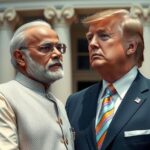Politics
AERO INDIA, ALEXANDER MIKHEEV, ASIA, BENGALURU, DEFENCE, DEFENSE, DEFENSE EXPORT AGENCY, DONALD TRUMP, EUROPE/ASIA, GEOPOLITICS, HAL, HINDUSTAN AERONAUTICS LIMITED, INDIA, INDIAN AIR FORCE, INTERNATIONAL RELATIONS, LOCKHEED MARTIN, MILITARY, NA, NARENDRA MODI, NORTH AMERICA, RO, ROSOBORONEXPORT, RUSSIA, RUSSIAN AIR FORCE, TRADE, TRUMP, UNITED STATES, WHITE HOUSE
Sophia Klein
India Evaluates U.S. and Russian Fighter Jet Offers Amidst Strategic Decisions
The Aero India 2025 exhibition marked a significant display of the Lockheed Martin F-35A and Sukhoi Su-57E as contenders for the Indian Air Force’s next generation of fighter jets. This moment illustrates India’s strategic balance between maintaining long-standing ties with Russia and expanding partnerships with the U.S. as it seeks to modernize its military capabilities amid complex technological and geopolitical challenges.
During the Aero India 2025 exhibition in Bengaluru, India, the Lockheed Martin F-35A and the Sukhoi Su-57E showcased their capabilities as potential additions to the Indian Air Force. This event highlights India’s non-aligned approach, considering both U.S. and Russian military offerings, amidst its historical reliance on Russian defense equipment while gradually increasing its engagement with American suppliers.
The current focus is on securing fifth-generation fighter jets, with Russia suggesting that the Su-57 could be manufactured domestically in India through technology transfer. Officials from Rosoboronexport have discussed potential partnerships with Hindustan Aeronautics Limited (HAL) to explore local production capabilities, particularly at HAL’s Nasik facility, where Su-30MKI jets are assembled.
India’s prior withdrawal from a collaborative Indo-Russian project for the Su-57, which was ultimately successful, adds a layer of complexity to the current bidding. Meanwhile, Alexander Mikheev, a Rosoboronexport executive, has announced that Algeria will be the first international customer for the Su-57E, indicating competitive positioning within the global market.
In mid-February, Indian Prime Minister Narendra Modi’s meeting with U.S. President Donald Trump resulted in a promise to provide the F-35 stealth fighters to India. This unprecedented commitment was reflected in a leaders’ statement indicating that the U.S. is reviewing its policy on releasing advanced fighters to India, which could deeply influence its defense procurement strategy.
Lockheed Martin welcomed President Trump’s assurances about the F-35, signifying a potential shift in India’s defense partners. However, Indian officials clarified that discussions regarding advanced aviation platforms had only just begun, emphasizing that this remains a proposal at the moment.
The procurement of either the F-35 or the Su-57 raises questions about compatibility with India’s existing military systems, particularly with regard to its Russian-designed aircraft. Moreover, the complexities surrounding integration into current command networks present substantial challenges, especially given the advanced technologies involved.
During the current geopolitical landscape, India remains committed to fostering self-reliance in defense capabilities, as evidenced by its Advanced Medium Combat Aircraft (AMCA) program. Notably, India unveiled a full-scale AMCA model at the Aero India event, signaling its ambition to develop indigenous military technology despite facing potential setbacks from foreign purchases.
India’s historical defense ties with Russia include approximately $50 billion in contracts over the last two decades. However, recent trends indicate a declining reliance on Russian military imports, which dropped by 34% in comparison to previous years, as India navigates a rapidly changing international defense market.
Having recently emerged as the world’s largest arms importer, India accounted for 10% of global arms purchases from 2008 to 2023. Reports noted that India’s military imports during this period were predominantly sourced from Russia, followed by France, the U.S., and Israel, while the U.S. strives to support India’s reduction of dependency on Russian military equipment.
The United States recognizes India’s significance as a defense market, with over $20 billion in transactions since 2008. Recent U.S. exports to India include a range of advanced military equipment, illustrating a growing defense relationship, augmented by new procurement deals planned for Javelin missiles and maritime aircraft.
In light of a 9.53% increase in India’s defense budget to $78.3 billion for 2025-2026, the Indian Armed Forces must modernize to remain combat-ready amid shifting warfare dynamics. Delhi must now make a pivotal decision regarding its defense strategy: whether to continue its historical reliance on Russia, engage with the U.S. through an F-35 acquisition, or invest fully in indigenous capabilities, risking a short-term strategic gap with China.
India finds itself at a crossroads in its defense procurement strategy. As it considers the offers of advanced fighter jets from both the U.S. and Russia, political and technical compatibility issues, along with the goal of fostering domestic defense production, complicate decision-making. Ultimately, India must balance enhancing its military capacity today with its long-term strategic objectives, all while navigating its historically nuanced relationships in defense partnerships.
Original Source: www.defensenews.com








Post Comment